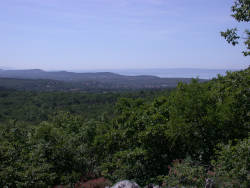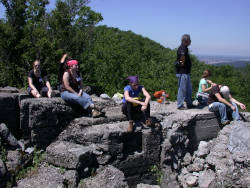Grotta della Gavetta e Grotta del Pilone
Grotte Karl e Zita - Karl- und Zita-Höhle
Useful Information


| Location: |
Walking trails from Brestovica pri Komnu in Slovenia and Medeazza or Ceroglie in Italy.
(45.793788739812356, 13.620877133231307) |
| Open: |
no restrictions. [2021] |
| Fee: |
free. [2021] |
| Classification: |
 Karst Cave Karst Cave
 World War I World War I
|
| Light: | bring torch |
| Dimension: |
Karl: L=90 m, VR=38 m, A=275 m asl. Zita: L=70 m, VR=27 m, A=272 m asl. |
| Guided tours: | self guided |
| Photography: | allowed |
| Accessibility: | no |
| Bibliography: |
Franco Gherlizza (2011):
Grotte di guerra sul Carso,
Itinerari ipogei in alcune grotte della Grande Guerra sul Carso triestino e goriziano.
112 pagine a colori - stampa tipografica - Trieste, 2011. Edito da "La Biblioteca del Piccolo" - Editoriale FVG spa.
 pdf
pdf
|
| Address: |
Museo all’Aperto del Monte Ermada, Ceroglie, Duino-Aurisina, 34011 Duino-Aurisina TS, Tel: +39-04313-87130.
Gruppo Speleologico Flondar, Villaggio del Pescatore, 102, I-34013 Duino Aurisina (TS), Tel: +39-040-209075-208853, Cell: +39-339-6908950. Trieste Infopoint, via dell’Orologio, 1 (angolo Piazza Unità d’Italia), I-34121 Trieste, Tel: +39-040-3478312. E-mail: |
| As far as we know this information was accurate when it was published (see years in brackets), but may have changed since then. Please check rates and details directly with the companies in question if you need more recent info. |
|
History
| World War I | part of the Austro-Hungarian fortifications. |
| 30-OCT-1988 | explored by cavers. |
| 2002 | surveyed by F. Gherbaz, C. Sgai, and F. Vidonis. |
Description
Grotta della Gavetta (Gavetta Cave) and Grotta del Pilone (Pilone Cave) are actually known under the name Karl- und Zita-Höhle (Karl and Zita Caves). The name was given to the caves by the Habsburg Imperial Command in honour of the new emperor who succeeded Kaser Franz Joseph, Karl I, and his wife, Zita of Bourbon. Both caves feature several levels connected by staircases, which were used as resting places. The stairs leading to the entrance of the Karl Cave were recently cleared, and the inside excavated by archaeologists. They also opened the narrow tunnel, which had initially been excavated by soldiers but was never completed. But it is now possible to walk from Karl to Zita Cave through this tunnel.
This cave is part of the Museo all’aperto del Monte Ermada (Open-air Museum of Mt. Ermada). It is a trail at the southern slope of Monte Ermada (Trench Hill, 323 m asl), between the villages Medeazza and Ceroglie. It shows the defensive line fortified in September 1916 following the 6th Battle of the Isonzo. The Italian victory had forced the Habsburg Imperial Army to abandon Monfalcone and move to this hill. The great Italian victory, which cost ten thousands of lives, changed the frontier by 6 km.
Mt. Ermada and the surrounding hilltops had massive strategic and practical advantages. They could control both the Valley of Brestovizza (Brestovica Dol, now part of Slovenia) and the passage to Trieste. Trenches, observation posts, and bunkers for soldiers were built in no time, creating an insurmountable barrier for the Italians. The sinkholes and the natural caves of the Karst Plateau were perfectly adapted to the needs of the war. All assaults by the Italian Third Army between the 8th and 10th Battle of the Isonzo were rejected. In the 10th battle alone 36.000 Italian soldiers were dead, 124.000 wounded or prisoner of war, on Austrian side 17.000 soldiers were dead, 108.000 wounded or prisoner of war.
 Search DuckDuckGo for "Grotta della Gavetta e Grotta del Pilone"
Search DuckDuckGo for "Grotta della Gavetta e Grotta del Pilone" Google Earth Placemark
Google Earth Placemark Open-air Museum of Mt. Ermada (visited: 02-JUN-2021)
Open-air Museum of Mt. Ermada (visited: 02-JUN-2021) Index
Index Hierarchical
Hierarchical Countries
Countries Maps
Maps